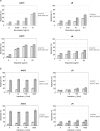Interferon-gamma sensitizes resistant Ewing's sarcoma cells to tumor necrosis factor apoptosis-inducing ligand-induced apoptosis by up-regulation of caspase-8 without altering chemosensitivity
- PMID: 17525260
- PMCID: PMC1899433
- DOI: 10.2353/ajpath.2007.060993
Interferon-gamma sensitizes resistant Ewing's sarcoma cells to tumor necrosis factor apoptosis-inducing ligand-induced apoptosis by up-regulation of caspase-8 without altering chemosensitivity
Abstract
Ewing's sarcoma cells are highly susceptible to apoptosis via tumor necrosis factor apoptosis-inducing ligand (TRAIL). Resistance to TRAIL has been linked to deficient expression of caspase-8 in vitro. Here, we report on the status of caspase-8 expression in tumors from patients with Ewing's sarcoma, the effect of interferon-gamma on caspase-8 expression and apoptosis, and the role of caspase-8 for TRAIL- and chemotherapy-mediated apoptosis in Ewing's sarcoma. Using immunohistochemistry, we show that low expression of caspase-8 is seen in about 24% of tumors. Interferon-gamma induces expression of caspase-8 at concentrations achievable in humans and sensitizes cells to TRAIL. Transfection of wild type but not mutant caspase-8 into caspase-8-deficient Ewing's sarcoma cells restored sensitivity to TRAIL, indicating that up-regulation of caspase-8 is sufficient to restore TRAIL sensitivity. In contrast, no role for caspase-8 in chemotherapy-induced apoptosis was identified, because 1) transfection of caspase-8 or treatment with interferon-gamma did not alter the sensitivity of caspase-8-deficient cells to chemotherapeutics, 2) application of chemotherapy did not select for caspase-8-negative tumor cells in vivo, and 3) the caspase-8 status of tumors did not influence survival after chemotherapy-based protocols. In conclusion, our data provide a rationale for the inclusion of interferon-gamma in upcoming clinical trials with TRAIL.
Figures








Similar articles
-
Preclinical evidence that use of TRAIL in Ewing's sarcoma and osteosarcoma therapy inhibits tumor growth, prevents osteolysis, and increases animal survival.Clin Cancer Res. 2010 Apr 15;16(8):2363-74. doi: 10.1158/1078-0432.CCR-09-1779. Epub 2010 Apr 6. Clin Cancer Res. 2010. PMID: 20371692
-
Sensitivity of Ewing's sarcoma to TRAIL-induced apoptosis.Cell Death Differ. 2001 May;8(5):506-14. doi: 10.1038/sj.cdd.4400836. Cell Death Differ. 2001. PMID: 11423911
-
Interferon gamma enhances the effectiveness of tumor necrosis factor-related apoptosis-inducing ligand receptor agonists in a xenograft model of Ewing's sarcoma.Cancer Res. 2004 Nov 15;64(22):8349-56. doi: 10.1158/0008-5472.CAN-04-1705. Cancer Res. 2004. PMID: 15548704
-
TRAIL-based therapy in pediatric bone tumors: how to overcome resistance.Future Oncol. 2015;11(3):535-42. doi: 10.2217/fon.14.293. Future Oncol. 2015. PMID: 25675131 Review.
-
TNF-related apoptosis-inducing ligand (TRAIL) for bone sarcoma treatment: Pre-clinical and clinical data.Cancer Lett. 2017 Nov 28;409:66-80. doi: 10.1016/j.canlet.2017.08.036. Epub 2017 Sep 6. Cancer Lett. 2017. PMID: 28888998 Review.
Cited by
-
Targeted therapy in Ewing sarcoma.ISRN Oncol. 2012;2012:609439. doi: 10.5402/2012/609439. Epub 2012 May 28. ISRN Oncol. 2012. PMID: 22690342 Free PMC article.
-
Bone tumors in adolescents and young adults.Curr Treat Options Oncol. 2008 Feb;9(1):67-80. doi: 10.1007/s11864-008-0057-1. Epub 2008 May 1. Curr Treat Options Oncol. 2008. PMID: 18449804 Review.
-
Proliferation index: a continuous model to predict prognosis in patients with tumours of the Ewing's sarcoma family.PLoS One. 2014 Aug 26;9(8):e104106. doi: 10.1371/journal.pone.0104106. eCollection 2014. PLoS One. 2014. PMID: 25157404 Free PMC article.
-
Fenretinide-dependent upregulation of death receptors through ASK1 and p38α enhances death receptor ligand-induced cell death in Ewing's sarcoma family of tumours.Br J Cancer. 2010 Oct 26;103(9):1380-90. doi: 10.1038/sj.bjc.6605896. Epub 2010 Sep 28. Br J Cancer. 2010. PMID: 20877355 Free PMC article.
-
Review of therapeutic strategies for osteosarcoma, chondrosarcoma, and Ewing's sarcoma.Med Sci Monit. 2011 Aug;17(8):RA177-190. doi: 10.12659/msm.881893. Med Sci Monit. 2011. PMID: 21804475 Free PMC article. Review.
References
-
- Abadie A, Besancon F, Wietzerbin J. Type I interferon and TNFalpha cooperate with type II interferon for TRAIL induction and triggering of apoptosis in SK-N-MC EWING tumor cells. Oncogene. 2004;23:4911–4920. - PubMed
-
- Thiele CJ. Biology of pediatric peripheral neuroectodermal tumors. Cancer Metastasis Rev. 1991;10:311–319. - PubMed
-
- Hawkins D, Barnett T, Bensinger W, Gooley T, Sanders J. Busulfan, melphalan, and thiotepa with or without total marrow irradiation with hematopoietic stem cell rescue for poor-risk Ewing-Sarcoma-Family tumors. Med Pediatr Oncol. 2000;34:328–337. - PubMed
-
- Paulussen M, Ahrens S, Braun-Munzinger G, Craft AW, Dockhorn-Dworniczak B, Dorffel W, Dunst J, Frohlich B, Gobel U, Haussler M, Klingebiel T, Koscielniak E, Mittler U, Rube C, Winkelmann W, Voute PA, Zoubek A, Jurgens H. [EICESS 92 (European Intergroup Cooperative Ewing’s Sarcoma Study): preliminary results]. Klin Padiatr. 1999;211:276–283. - PubMed
Publication types
MeSH terms
Substances
Grants and funding
LinkOut - more resources
Full Text Sources
Other Literature Sources
Medical

